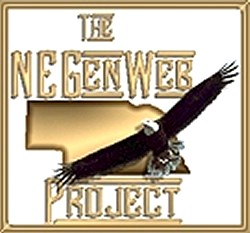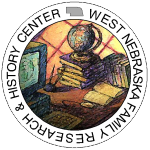History of the Community, the Church, the Cemetery Record of Burials
From: Sioux County – memoirs of its Pioneers
Bodarc is a corruption of the French bois d’arc, a thorny shrub or small tree, native of Texas, usually designated as the Osage orange and frequently used for hedges. John W. Hunter and C. F. Slingerland wanted a name for their post office, and suggested Oress for Hunter’s little daughter. A Texas community asked that their post office be named Bodarc for their native shrub, and the postal department in Washington, by mistake, assigned the name Bodarc to the Sioux Co., NE post office, and Oressa to the one in Texas.
Excerpt from a letter to the Harrison Sun newspaper in 1951 from the Rev. Emery E. Zimmerman, Carroll, Iowa
“We had been out of school about 2 years and were happy when Dist. 6 began its session in the Columbia house. Ben Smith was teacher, and too tall for the ceiling, had some hard bumps on the head, and his temper would flare with very audible expression. One teacher was Herbert Steele, who died of mountain fever, and was the first one buried in Bodarc cemetery . . . The “stickers-on”, most of them now passed on to the last home, certainly earned the heritage you now enjoy in a time of plenty. Learning to “hoe your own row” hurts no youngster”.
Bodarc Community Church
by – Grace Wickersham Skavdahl
Bodarc Church and Cemetery are located: Sec. 27, Twp 33, Range 55 in Sioux Co., NE
Olita (Mrs. Keith) Zimmerman keeps records current.
From 1885-1890 Hat Creek Valley was being settled with a family on almost every quarter-section, and the Presbyterian missionary, Reverend Rice, and his good wife traveled many miles by buggy to encourage settlers in every way, but especially to meet for Sunday worship. Sunday School was held in the log schoolhouse, with Mrs. F. W. Knott a devoted superintendent. The congregation outgrew the schoolhouse, and they voted to build in 1890. The settlers represented various denomination, and voted to accept a $300 loan from the Presbyterian mother church, Rev. Rice to serve as first minister. A sawmill owner volunteered to saw the lumber if men would get out the logs, which were on government land. Logs were cut and hauled to the site donated by Henry Zimmerman; Z. T. Zerbe drew the plans and helped in construction as well as overseeing; almost all the labor was donated. Cleve Zimmerman recalled playing around the work site at nights while his father and other men built by lantern light after a day’s work in their fields.
The churchyard cemetery’s first burial was Herbert Steele, a fine young teacher who came west for his health but never recovered, and was laid to rest by friends, as relatives could not be located. Then John Eberspecher’s two small sons and Matt Hall’s two little boys, all victims of membraneous croup, were next laid there, and some graves were moved to the churchyard from homesteads.
After Rev. Rice’s health failed, Presbyterian ministers serving Glen and Cottonwood came every 3rd week to Bodarc. Mrs. Maggie Brown Childs played an old treadle organ, and how the people san! Mrs. William Miller and Howard Wickersham were later Sunday School superintendents, and for years the many families ate Sunday picnic dinners at the grounds near Hat Creek, the you folks afterward singing and playing games while parents visited.
Settlers donating labor to build the church included:
| J. B. Burke | A. Southworth | F. W. Knott |
| W. S. Hall | S. Wolheter | E. Wolheter |
| J. H. Newlin | Charles Newman | Henry Zimmerman |
| J. H. Montgomery | Amelia Smith | Eli Smith |
| F. M. Hall | S. W. Hall | El Rickard |
| Lewis Gerlach | Minnie Crane | John Eberspecher |
| L. A. Pfost | W. D. Lafferty | Sanford Hill |
| Ernest Bunge | H. T. Zerbe | M. J. Blewett |
| Marstellar Brothers | D. H. Griswold | Alvin J. Clark |
| Haugh & Sons | W. H. Davis | Dr. J. E. Phinney |
| James Scott | J. W. Smith | C. E. Wilson |
| C. F. Adams | G. W. Hester | George C. Read |
| Alexander Steel | John Christian | A. A. Smith |
| J. C. Parsons | L. N. Freeman | A. Prinaux |
| C. F. Coffee | S. B. Coffee | J. B. Bradley |








 Users Today : 51
Users Today : 51 Users Yesterday : 43
Users Yesterday : 43 This Month : 1375
This Month : 1375 This Year : 3557
This Year : 3557 Total Users : 86634
Total Users : 86634 Views Today : 56
Views Today : 56 Total views : 208697
Total views : 208697 Who's Online : 2
Who's Online : 2